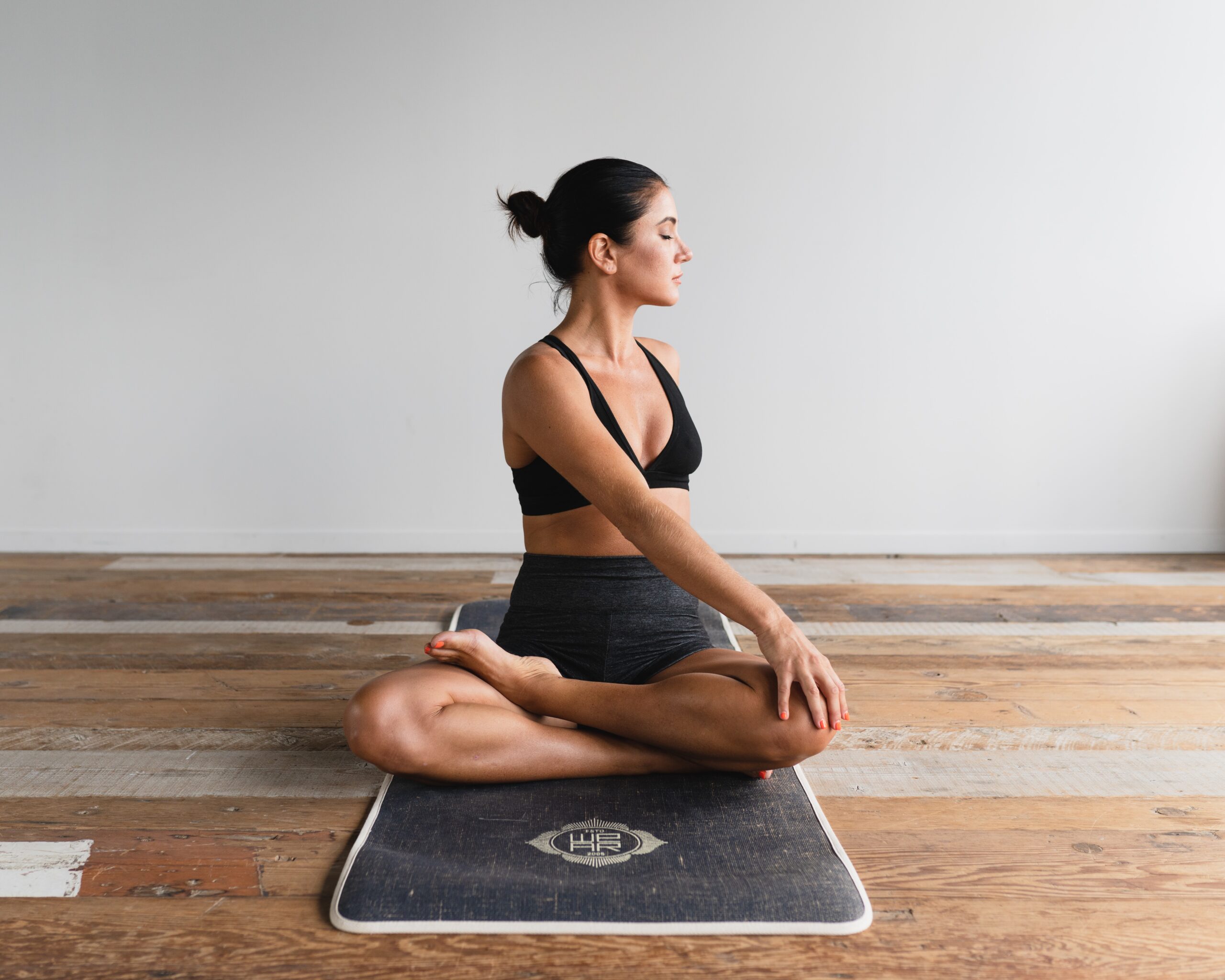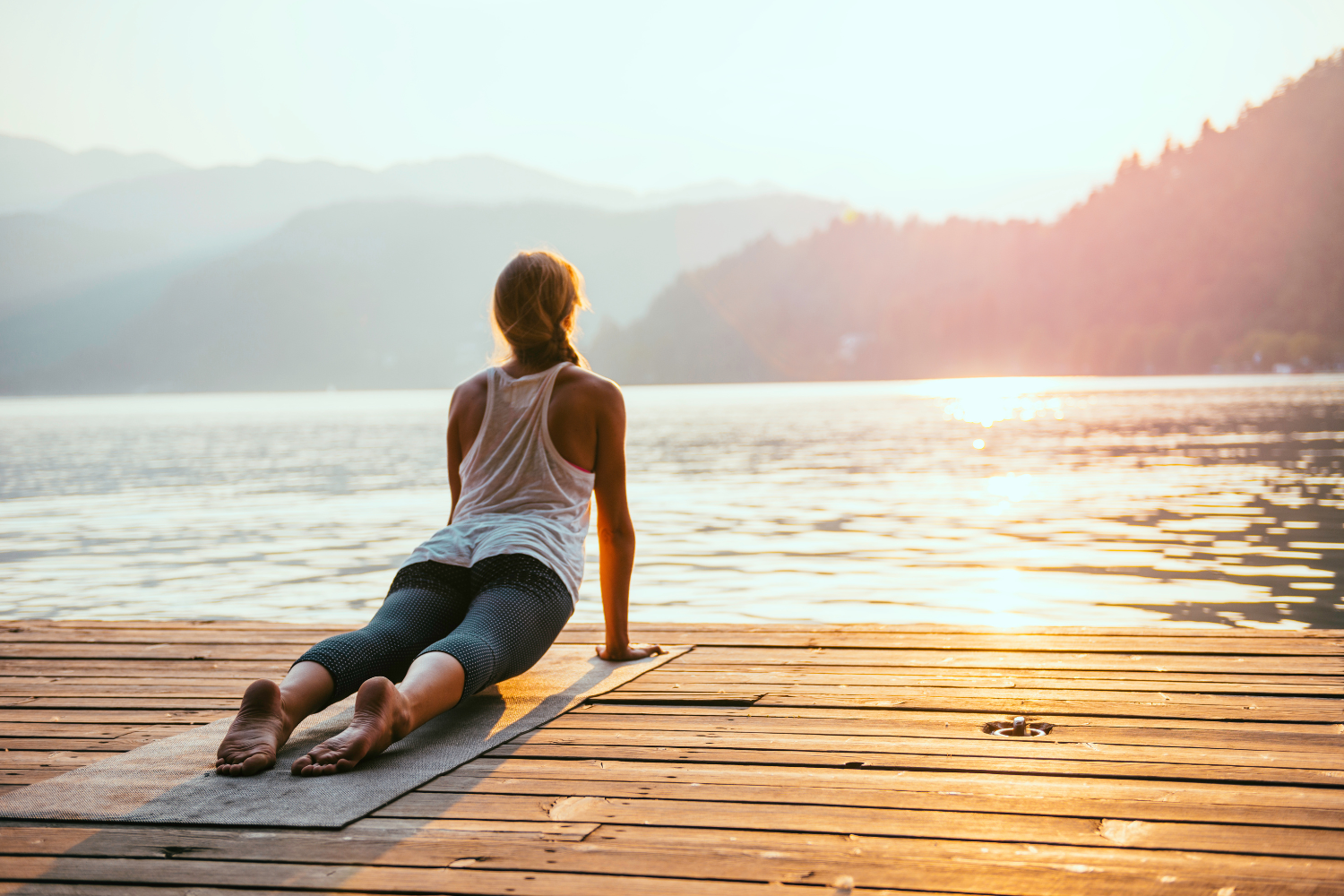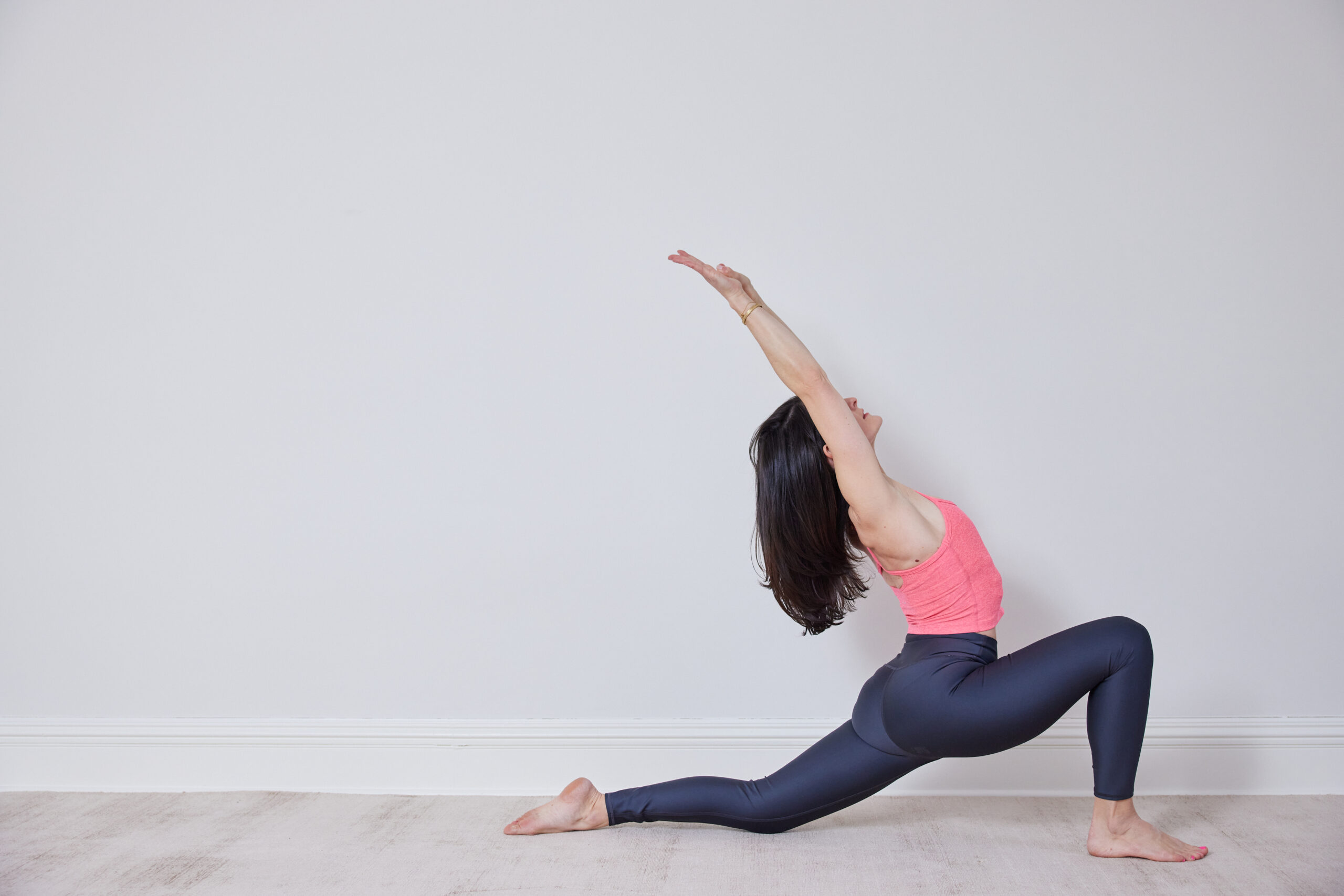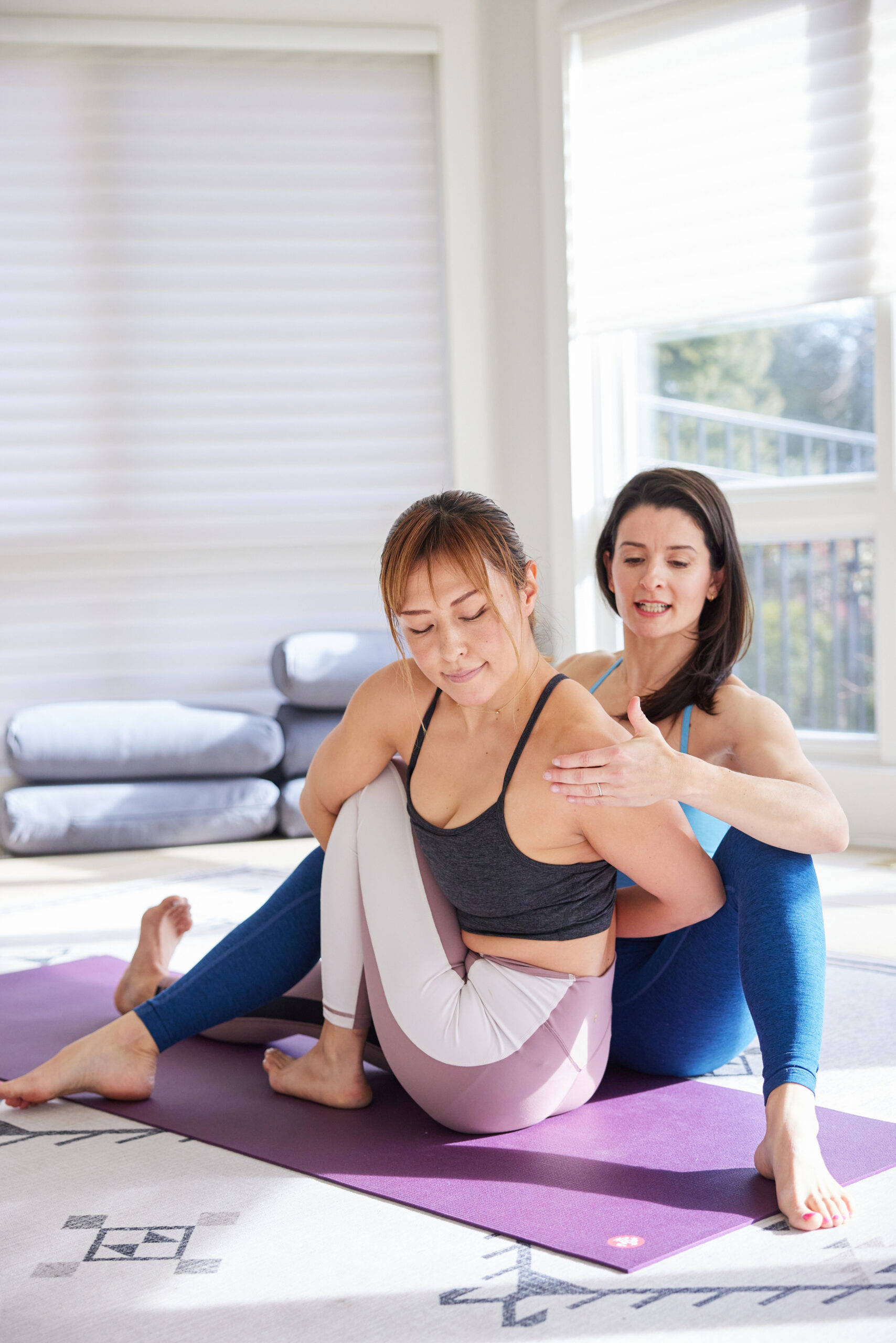What is Vinyasa Yoga?
A Complete Beginners Guide For Starting An Ashtanga Yoga Practice
More than a yoga practice, Ashtanga yoga is a yoga system.
Its roots trace back approximately 2000 years ago when Patanjali’s classical yoga text “The Yoga Sutras” defined Ashtanga yoga as the 8-limb path to liberation.
It has a reputation for being the “athletic” type of yoga but this is a very obscured lens to see it through. Ashtanga yoga actually paved the way for other forms of yoga to develop and diversify. Styles like Vinyasa and Hatha styles of yoga.
Ashtanga yoga is a vibrant and timeless path into the realm of yoga.
Though it can be a vigorous physical practice, the heart of it is about the ultimate connection with your mind, body, breath, and spirit.
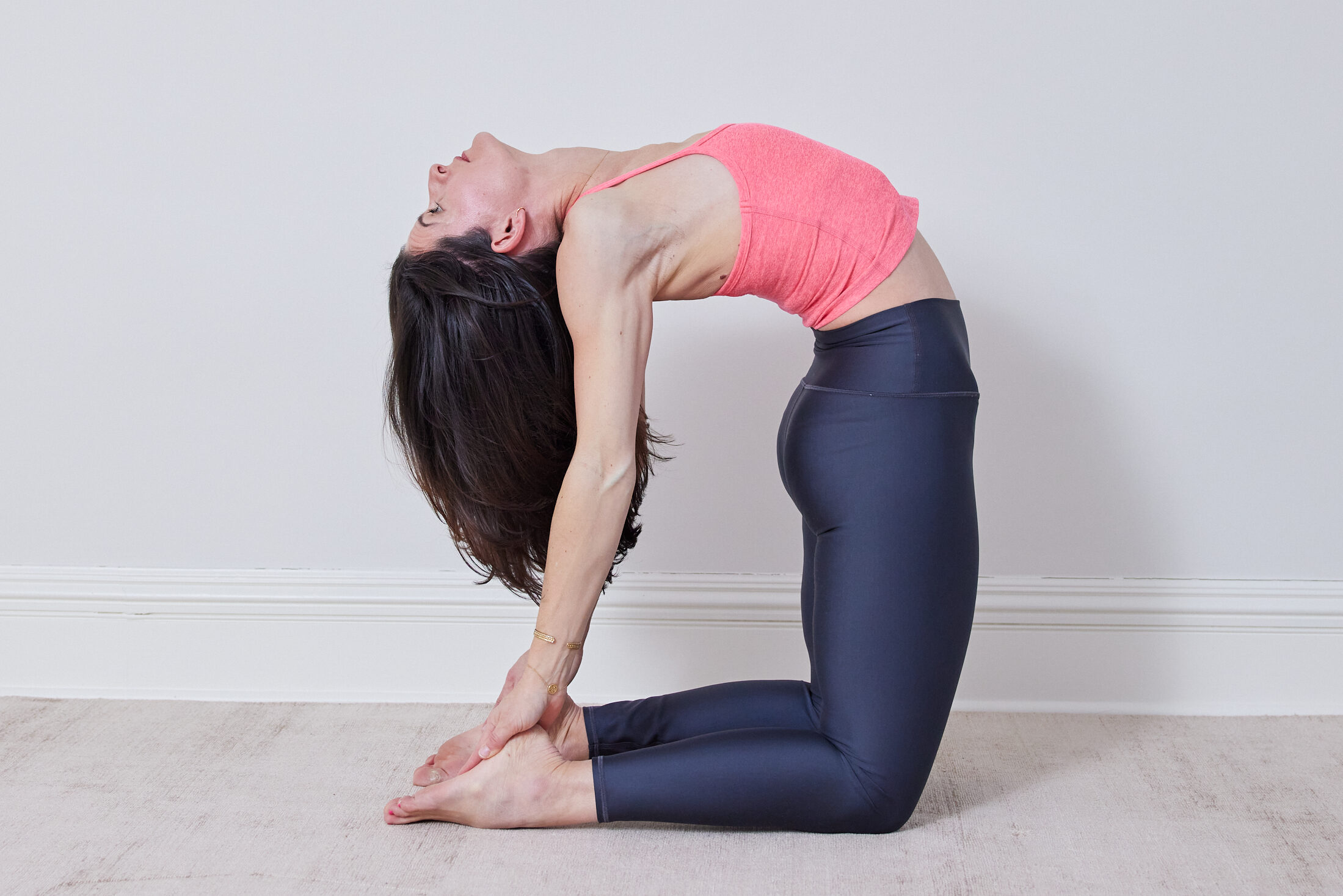
This article aims to be your Ashtanga yoga guide and will look at:
- What is Ashtanga?
- The origin of Ashtanga (Vinyasa) Yoga
- Key principles of Ashtanga Yoga:
- What is the purpose of Ashtanga yoga?
- The Benefits of Ashtanga Yoga
- Ashtanga Yoga Series
- Led Ashtanga Vs. Mysore Ashtanga style
- Is Ashtanga yoga for me and is it beginner-friendly?
- Tips to start an Ashtanga practice
Let’s dive right in!
What is Ashtanga?
Ashtanga is Sanskrit for eight limbs, Asta (eight), and Anga (limbs).
Ashtanga yoga is the eight-limb science of classical yoga as explained in Patanjali’s Yoga Sutras.
The yoga sutras are verses containing the ancient teachings of yoga, providing the framework for yoga philosophy and teachings.
The ancient sage Patanjali is credited for systematizing and compiling existing ideas and practices of yoga and transmitting them through what is known today as Patanjali’s Yoga Sutras.
He is known today as the father or architect of classical yoga.
The Yoga Sutras are known as the primary scripture of yoga, and the basis for all the various types of meditation and yoga.
Sutra is Sanskrit for “thread”. These Yoga threads create the tapestry of yoga as we practice today.
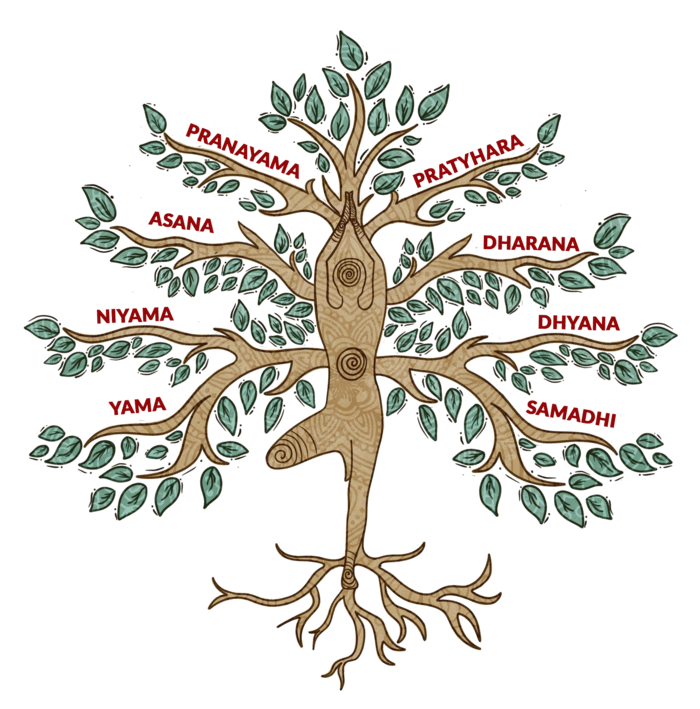
The eight limbs of yoga are:
- Yama (self restraints)
- Niyama (self practices)
- Asana (poses)
- Pranayama (control of the breath)
- Pratyahara (withdrawal of the senses)
- Dharana (one-pointed concentration)
- Dhyana (meditation)
- Samadhi (enlightenment)
The first four are taught to us through practice and relationship with the external world.
The remaining four are caught through inner reflection and meditation with our inner world.
It’s important to talk about the eight-limb path as it is the foundation of where Ashtanga yoga takes root.
Is Ashtanga Yoga classical or modern?
Ashtanga yoga can be both depending on how you look at it.
Ashtanga yoga in a classical sense refers to what we’ve just discussed in Patanjali’s 8-limb yoga path where it has deep philosophical roots and ethical guidelines barely mentioning physical practice.
In a modern sense, Ashtanga yoga created by K. Pattabhi Jois in the 20th century remains rooted in the philosophy of the sutras while also focusing on the importance of asana, concentration, and breath.
This intersection of the eight limbs with physical practice is what creates Ashtanga yoga as we practice it today.
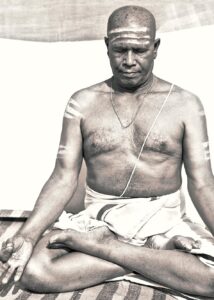
The origin of Ashtanga (Vinyasa) Yoga
Ashtanga Yoga, also referred to as Ashtanga Vinyasa Yoga, is a powerful form of yoga that links breath, movement, and concentration to detox the mind, body, and spirit from impurities and bring you into a state of purification and equanimity.
Sri Pattabhi Jois was a student of guru and revered yogi T. Krishnamacharya and learned asana with him as his mentor. Together they practiced breathwork and practice of the poses and from there created his own version of yoga, Mysore or Ashtanga yoga.
Key principles of Ashtanga Yoga:
Ashtanga Yoga utilizes these key elements as a formula for creating a focused and meditative state during practice.
- Vinyasa: connects to the body and breath (outward connection)
- Tristana: three elements which are 1. Ujjayi (Breath), 2. Dishtri (gaze or concentration), 3. Bandha (energy seal). They are meant to connect you with the mind, breath, and energy (inwards connection)
- Daily Practice: Consistent and dedicated practice is what creates the tapas (fire) for ultimate results. It also aims to improve your physical capabilities and overall well-being.
“Practice and all is coming.”- Pattabhi Jois
What is the Purpose of Ashtanga Yoga?
Ashtanga yoga aims to refine the yogi’s mind and body in order to enhance their quality of life and reach their full potential.
Coming back to a classical sense of yoga, it is the science of mastery of the mind fluctuations.
In Ashtanga yoga, the breath and movement are synchronized to create ultimate focus and generate internal body heat.
“When breath feeds action, and action feeds posture, each movement becomes gentle, precise, and perfectly steady”. – Richard Freeman
What is the difference between Ashtanga and Vinyasa Yoga?
Vinyasa yoga is derived from Ashtanga yoga. Ashtanga is a set sequence of asanas that will be the same every time. Vinyasa is more free-style and improvised.
Ashtanga Yoga Sequences
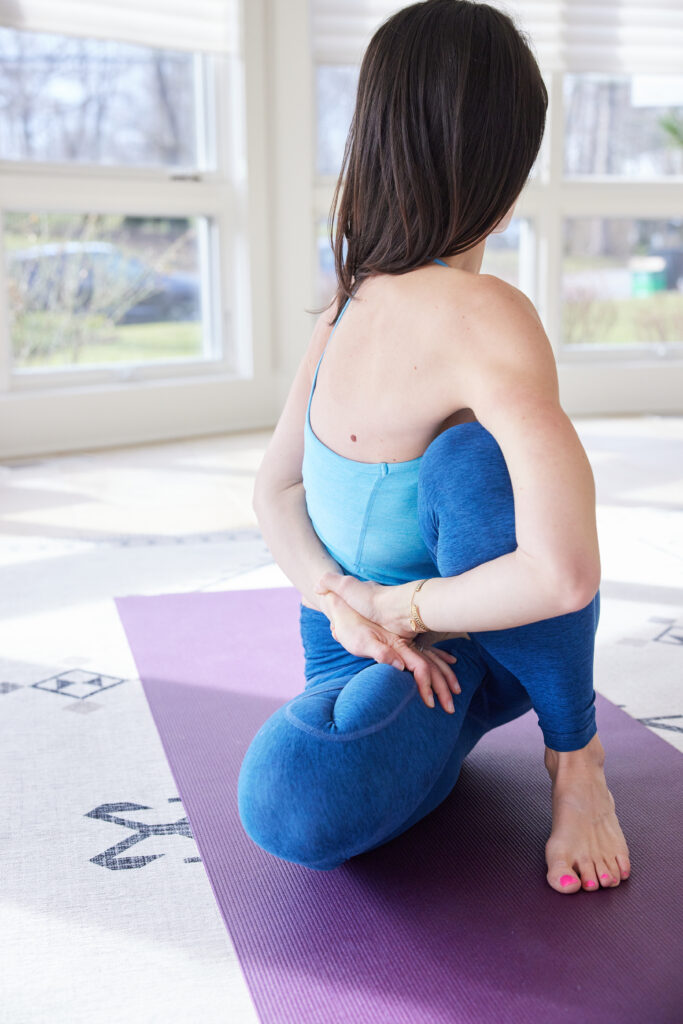
Twist in the Primary Series
There are three series groups consisting of asana sequences practiced in a specific order in the Ashtanga system.
The Primary Series (Yoga Chikitsa)– detoxifies and aligns the body. meaning yoga therapy in Sanskrit
The Intermediate Series (Nadi Shodhana) – purifies the nervous system by opening and clearing the energy channels. channel (nadi) shodhana (purification)
The Advanced Series (Sthira Bhaga)- A, B, C, and D integrates the strength and grace of the practice, requiring higher levels of flexibility and humility. Sthira (steady) Bhaga (happiness).
Each level is to be fully developed before proceeding to the next, and the sequential order of asanas is to be meticulously followed as concentration, strength, and stamina are cultivated in a safe and cautious manner.
Each posture is a preparation for the next, developing the strength and balance required to move further.
Your instructor will advise you when it is time to move to the next series.
Benefits of Ashtanga yoga
- Detoxifies the body
- Releases a flow of vital hormones and minerals into the bloodstream
- Replenishes the nervous system
- Improved strength and flexibility
- The intense physical aspect of Ashtanga helps breakdown mental and emotional blocks
- Sharp focus and clarity as it emphasizes concentration
- Improved breathing capacity
- Endurance and stamina-building
- Core strength and muscle tone
- Connection to our mind and spirit as it works with both energetic flow
The Primary Series (yoga chikitsa)
The primary series in Ashtanga (yoga chikitsa) includes 48 asanas that cleanse and tune the physical body.
The practice of the Ashtanga Primary Series begins with the fundamental asanas five rounds of Surya Namaskar A and B also known as sun salutations. This helps to set up the breathing pattern for moving with one breath per pose.

Fundamental Poses
- Big toe pose (padangusthasana)
- Hands under feet (pada hastasana)
- Triangle (trikonasana)
- Revolved Triangle (parivrtta trikonasana)
- Extended side angle (parsva konasana)
- Revolved side angle (parivrtta parsva konasana)
- Wide-legged forward fold (Prasarita Padotanasana)
- Side intense stretch (parsvottanasana)
Primary series begins
Standing Poses
- Extended hand to big toe posture (Utthita hasta padangusthasana)
- Half-bound lotus intense stretch (Ardha baddha padma uttanasana)
- Chair pose (utkatasana)
- Warrior one (Virabhadrasana one)
- Warrior two (Virabhadrasana two)
Standing Poses
- Staff pose (dandasana)
- Paschimottanasana (seated forward bend)
- Purvottanasana (upward plank pose)
- Head to knee forward bend (janu sisrsasana)
- Seated spinal twist (marychasana a, b, c, and d)
- Boat pose (navasana) five times (with down dog in between)
- Arm pressure pose (Bhujapidasana) – jump back from crow
- Toirtoise (kurmasana)
- Reclining tortoise (supta kurmasana)
- Embryo in the womb (garbha pindasana)
- Rooster (Kukkutasana)
- Bound angle (baddha konasana)
- Vinyasa (four limb staff, updog, downdog)
- Wide angle pose (upavista konasana)
- Reclining angle pose (supta konasana)
- Reclining bog toe pose A and B ( reclining big toe pose A and B)
- Both big toes pose (ubhaya padangustasana)
- Upward facing paschimottansasna (urdhva mukha paschiamottansana)
- Bridge pose (setu bandhasana)
Finishing Sequence
- Upward bow (urdvha Dhanurasana) five times
- Intense stretch (paschimottanasana)
- Corpse (Savasana)
- Shoulderstand (Salamba Sarvangasana)
- Plow (Halasana)
- Ear pressure (karnapidasana)
- Upward lotus (urdvha Padmasana)
- Embryo (pindasana in Sarvangasana)
- Fish (Matsyasana)
- Intense stretched feet or legs (uttana Padasana)
- Headstand (sirsasana) – A for 10 – 50 breaths B for 10 breaths
- Child’s pose (balasana)
Final poses
- Bound lotus and bow (baddha Padmasana)
- Lotus (padmasana)
- Scales (tolasana)
- Vinyasa
- Corpse (savasana)
Led versus “Mysore” style
Mysore is a city in India from which Mysore yoga is Named after. The creator of Mysore yoga, Patabhi Jois, lived here when he created the traditional style of yoga which led to the Ashtanga yoga we see today.
Naturally, Mysore yoga became what we know today as Ashtanga and two branches were created, Ashtanga Led and Ashtanga Mysore.
Ashtanga Led: Students are led by a teacher through the primary, intermediate, and advanced series together.
Mysore-style Ashtanga: Students practice openly moving through the same sets of asanas in each sequence but at each one’s own pace.
Mysore yoga is a lot more personalized as the teacher can focus on more hands-on adjustments as opposed to teaching since the students guide themselves and allow themselves to be molded by the teachers.
Is Ashtanga yoga for me and is it beginner-friendly?
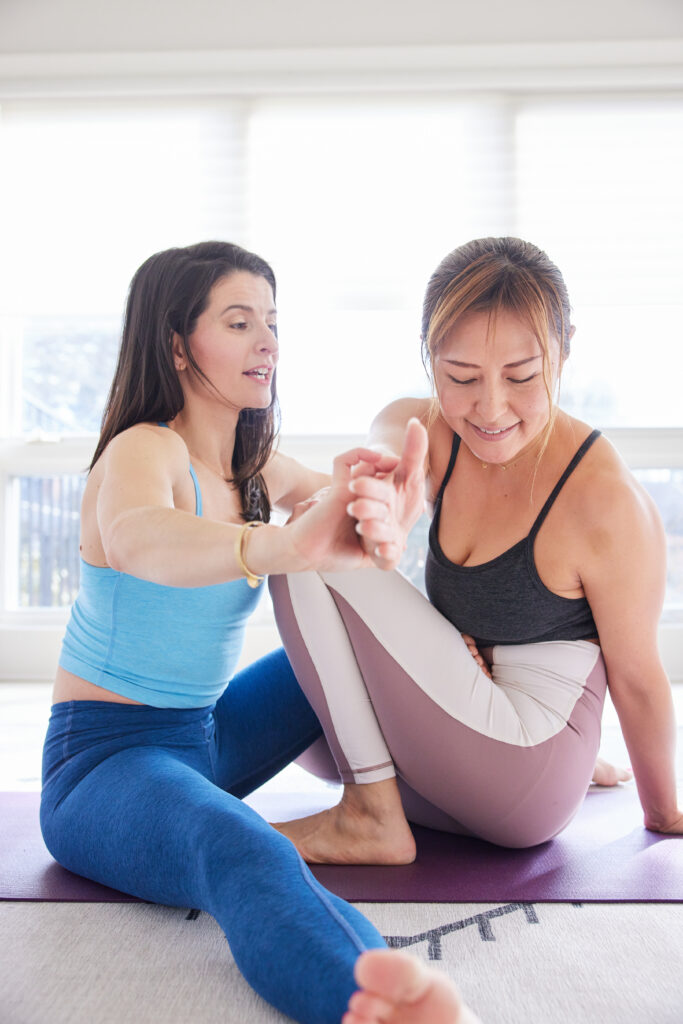
Yes, Ashtanga yoga is beginner friendly although it does require discipline and physical endurance. Since it comes with set sequences it is structured and precise allowing you to track your growth in all areas of your practice over time.
Another reason Ashtanga yoga is great for beginners is that its teachers are seasoned individuals who care deeply about the rich heritage and philosophy of classical yoga.
They are skilled teachers imparting the wisdom of Ashtanga yoga in modern times and will take their time applying the methods and helping guide students through it with proper alignment and breath control.
Ashtanga yoga is perfect for beginners because it is supportive, meticulous, and disciplined leading to a higher chance of success and sticking with yoga for the long run.
In conclusion
Ultimately Ashtanga yoga is a journey towards health, liberation, and happiness. It’s a path of self-discovery leading you to your highest good.
It is a dedicated and rigorous practice that when done with devotion and consistency can yield tremendous benefits for the mind, body, and soul.
If you are new to Ashtanga yoga, be sure to seek guidance from an experienced teacher. Start slowly and build up your practice over time.
If you are looking to begin practicing Ashtanga yoga in Greenwich, NY come practice with me at my Yoga Shala for small and personalized Ashtanga yoga classes.
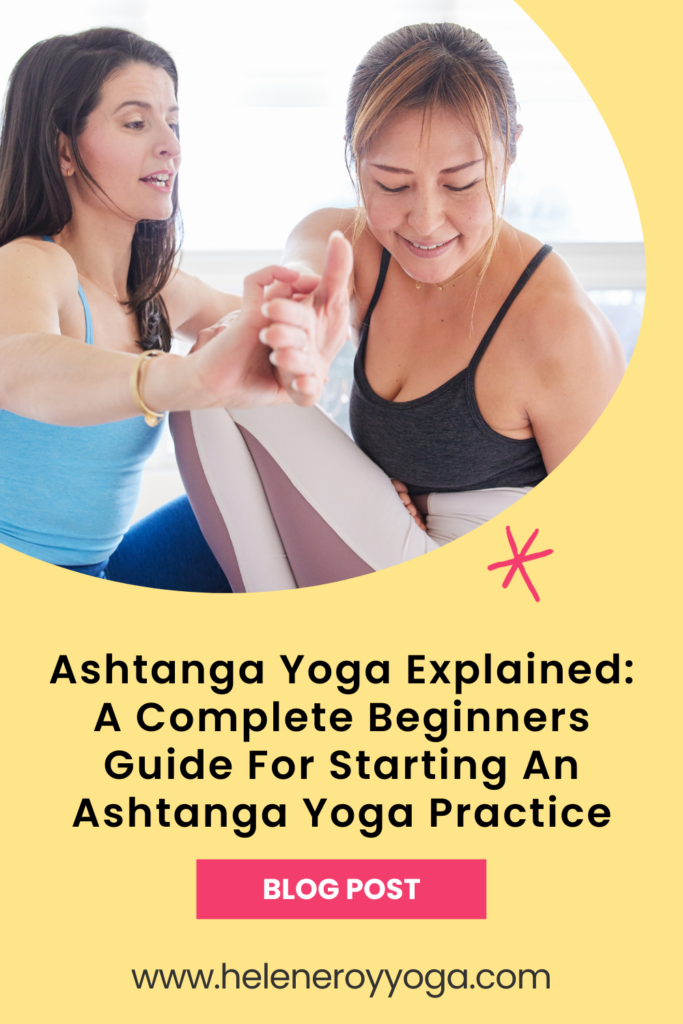
I understand what it's like to desire more out of life and look to yoga as a path to wellbeing. Your practice can awaken new perspectives as you tune in with your physical and emotional body.
When I started practicing, my finance career was at its height of success. I had the fancy job title but lacked fulfillment. I found the more I leaned into the yogic path, the more my whole life came into alignment.
I'm Hélène
Hey there!
more about me
FREE DOWNLOAD
Steal This
Get Your Ashtanga
Starter Kit
Practice With Me
group classes
private YOGA
WORKSHOPS
RETREATS
What is Ashtanga Yoga?
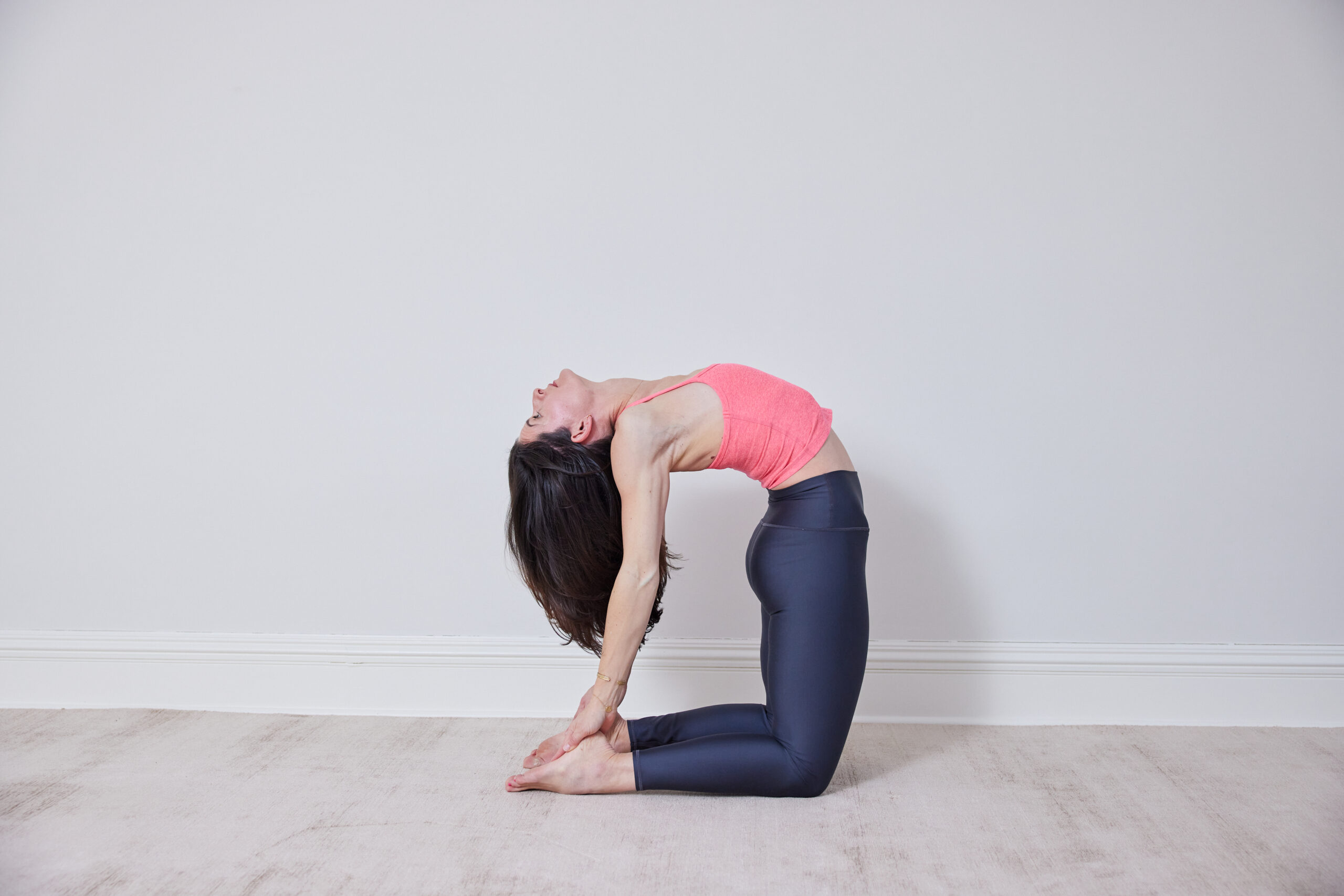
A Complete Beginners Guide For Starting An Ashtanga Yoga Practice
More than a yoga practice, Ashtanga yoga is a yoga system.
Its roots trace back approximately 2000 years ago when Patanjali’s classical yoga text “The Yoga Sutras” defined Ashtanga yoga as the 8-limb path to liberation.
It has a reputation for being the “athletic” type of yoga but this is a very obscured lens to see it through. Ashtanga yoga actually paved the way for other forms of yoga to develop and diversify. Styles like Vinyasa and Hatha styles of yoga.
Ashtanga yoga is a vibrant and timeless path into the realm of yoga.
Though it can be a vigorous physical practice, the heart of it is about the ultimate connection with your mind, body, breath, and spirit.

This article aims to be your Ashtanga yoga guide and will look at:
- What is Ashtanga?
- The origin of Ashtanga (Vinyasa) Yoga
- Key principles of Ashtanga Yoga:
- What is the purpose of Ashtanga yoga?
- The Benefits of Ashtanga Yoga
- Ashtanga Yoga Series
- Led Ashtanga Vs. Mysore Ashtanga style
- Is Ashtanga yoga for me and is it beginner-friendly?
- Tips to start an Ashtanga practice
Let’s dive right in!
What is Ashtanga?
Ashtanga is Sanskrit for eight limbs, Asta (eight), and Anga (limbs).
Ashtanga yoga is the eight-limb science of classical yoga as explained in Patanjali’s Yoga Sutras.
The yoga sutras are verses containing the ancient teachings of yoga, providing the framework for yoga philosophy and teachings.
The ancient sage Patanjali is credited for systematizing and compiling existing ideas and practices of yoga and transmitting them through what is known today as Patanjali’s Yoga Sutras.
He is known today as the father or architect of classical yoga.
The Yoga Sutras are known as the primary scripture of yoga, and the basis for all the various types of meditation and yoga.
Sutra is Sanskrit for “thread”. These Yoga threads create the tapestry of yoga as we practice today.

The eight limbs of yoga are:
- Yama (self restraints)
- Niyama (self practices)
- Asana (poses)
- Pranayama (control of the breath)
- Pratyahara (withdrawal of the senses)
- Dharana (one-pointed concentration)
- Dhyana (meditation)
- Samadhi (enlightenment)
The first four are taught to us through practice and relationship with the external world.
The remaining four are caught through inner reflection and meditation with our inner world.
It’s important to talk about the eight-limb path as it is the foundation of where Ashtanga yoga takes root.
Is Ashtanga Yoga classical or modern?
Ashtanga yoga can be both depending on how you look at it.
Ashtanga yoga in a classical sense refers to what we’ve just discussed in Patanjali’s 8-limb yoga path where it has deep philosophical roots and ethical guidelines barely mentioning physical practice.
In a modern sense, Ashtanga yoga created by K. Pattabhi Jois in the 20th century remains rooted in the philosophy of the sutras while also focusing on the importance of asana, concentration, and breath.
This intersection of the eight limbs with physical practice is what creates Ashtanga yoga as we practice it today.

The origin of Ashtanga (Vinyasa) Yoga
Ashtanga Yoga, also referred to as Ashtanga Vinyasa Yoga, is a powerful form of yoga that links breath, movement, and concentration to detox the mind, body, and spirit from impurities and bring you into a state of purification and equanimity.
Sri Pattabhi Jois was a student of guru and revered yogi T. Krishnamacharya and learned asana with him as his mentor. Together they practiced breathwork and practice of the poses and from there created his own version of yoga, Mysore or Ashtanga yoga.
Key principles of Ashtanga Yoga:
Ashtanga Yoga utilizes these key elements as a formula for creating a focused and meditative state during practice.
- Vinyasa: connects to the body and breath (outward connection)
- Tristana: three elements which are 1. Ujjayi (Breath), 2. Dishtri (gaze or concentration), 3. Bandha (energy seal). They are meant to connect you with the mind, breath, and energy (inwards connection)
- Daily Practice: Consistent and dedicated practice is what creates the tapas (fire) for ultimate results. It also aims to improve your physical capabilities and overall well-being.
“Practice and all is coming.”- Pattabhi Jois
What is the Purpose of Ashtanga Yoga?
Ashtanga yoga aims to refine the yogi’s mind and body in order to enhance their quality of life and reach their full potential.
Coming back to a classical sense of yoga, it is the science of mastery of the mind fluctuations.
In Ashtanga yoga, the breath and movement are synchronized to create ultimate focus and generate internal body heat.
“When breath feeds action, and action feeds posture, each movement becomes gentle, precise, and perfectly steady”. – Richard Freeman
What is the difference between Ashtanga and Vinyasa Yoga?
Vinyasa yoga is derived from Ashtanga yoga. Ashtanga is a set sequence of asanas that will be the same every time. Vinyasa is more free-style and improvised.
Ashtanga Yoga Sequences

Twist in the Primary Series
There are three series groups consisting of asana sequences practiced in a specific order in the Ashtanga system.
The Primary Series (Yoga Chikitsa)– detoxifies and aligns the body. meaning yoga therapy in Sanskrit
The Intermediate Series (Nadi Shodhana) – purifies the nervous system by opening and clearing the energy channels. channel (nadi) shodhana (purification)
The Advanced Series (Sthira Bhaga)- A, B, C, and D integrates the strength and grace of the practice, requiring higher levels of flexibility and humility. Sthira (steady) Bhaga (happiness).
Each level is to be fully developed before proceeding to the next, and the sequential order of asanas is to be meticulously followed as concentration, strength, and stamina are cultivated in a safe and cautious manner.
Each posture is a preparation for the next, developing the strength and balance required to move further.
Your instructor will advise you when it is time to move to the next series.
Benefits of Ashtanga yoga
- Detoxifies the body
- Releases a flow of vital hormones and minerals into the bloodstream
- Replenishes the nervous system
- Improved strength and flexibility
- The intense physical aspect of Ashtanga helps breakdown mental and emotional blocks
- Sharp focus and clarity as it emphasizes concentration
- Improved breathing capacity
- Endurance and stamina-building
- Core strength and muscle tone
- Connection to our mind and spirit as it works with both energetic flow
The Primary Series (yoga chikitsa)
The primary series in Ashtanga (yoga chikitsa) includes 48 asanas that cleanse and tune the physical body.
The practice of the Ashtanga Primary Series begins with the fundamental asanas five rounds of Surya Namaskar A and B also known as sun salutations. This helps to set up the breathing pattern for moving with one breath per pose.

Fundamental Poses
- Big toe pose (padangusthasana)
- Hands under feet (pada hastasana)
- Triangle (trikonasana)
- Revolved Triangle (parivrtta trikonasana)
- Extended side angle (parsva konasana)
- Revolved side angle (parivrtta parsva konasana)
- Wide-legged forward fold (Prasarita Padotanasana)
- Side intense stretch (parsvottanasana)
Primary series begins
Standing Poses
- Extended hand to big toe posture (Utthita hasta padangusthasana)
- Half-bound lotus intense stretch (Ardha baddha padma uttanasana)
- Chair pose (utkatasana)
- Warrior one (Virabhadrasana one)
- Warrior two (Virabhadrasana two)
Standing Poses
- Staff pose (dandasana)
- Paschimottanasana (seated forward bend)
- Purvottanasana (upward plank pose)
- Head to knee forward bend (janu sisrsasana)
- Seated spinal twist (marychasana a, b, c, and d)
- Boat pose (navasana) five times (with down dog in between)
- Arm pressure pose (Bhujapidasana) – jump back from crow
- Toirtoise (kurmasana)
- Reclining tortoise (supta kurmasana)
- Embryo in the womb (garbha pindasana)
- Rooster (Kukkutasana)
- Bound angle (baddha konasana)
- Vinyasa (four limb staff, updog, downdog)
- Wide angle pose (upavista konasana)
- Reclining angle pose (supta konasana)
- Reclining bog toe pose A and B ( reclining big toe pose A and B)
- Both big toes pose (ubhaya padangustasana)
- Upward facing paschimottansasna (urdhva mukha paschiamottansana)
- Bridge pose (setu bandhasana)
Finishing Sequence
- Upward bow (urdvha Dhanurasana) five times
- Intense stretch (paschimottanasana)
- Corpse (Savasana)
- Shoulderstand (Salamba Sarvangasana)
- Plow (Halasana)
- Ear pressure (karnapidasana)
- Upward lotus (urdvha Padmasana)
- Embryo (pindasana in Sarvangasana)
- Fish (Matsyasana)
- Intense stretched feet or legs (uttana Padasana)
- Headstand (sirsasana) – A for 10 – 50 breaths B for 10 breaths
- Child’s pose (balasana)
Final poses
- Bound lotus and bow (baddha Padmasana)
- Lotus (padmasana)
- Scales (tolasana)
- Vinyasa
- Corpse (savasana)
Led versus “Mysore” style
Mysore is a city in India from which Mysore yoga is Named after. The creator of Mysore yoga, Patabhi Jois, lived here when he created the traditional style of yoga which led to the Ashtanga yoga we see today.
Naturally, Mysore yoga became what we know today as Ashtanga and two branches were created, Ashtanga Led and Ashtanga Mysore.
Ashtanga Led: Students are led by a teacher through the primary, intermediate, and advanced series together.
Mysore-style Ashtanga: Students practice openly moving through the same sets of asanas in each sequence but at each one’s own pace.
Mysore yoga is a lot more personalized as the teacher can focus on more hands-on adjustments as opposed to teaching since the students guide themselves and allow themselves to be molded by the teachers.
Is Ashtanga yoga for me and is it beginner-friendly?

Yes, Ashtanga yoga is beginner friendly although it does require discipline and physical endurance. Since it comes with set sequences it is structured and precise allowing you to track your growth in all areas of your practice over time.
Another reason Ashtanga yoga is great for beginners is that its teachers are seasoned individuals who care deeply about the rich heritage and philosophy of classical yoga.
They are skilled teachers imparting the wisdom of Ashtanga yoga in modern times and will take their time applying the methods and helping guide students through it with proper alignment and breath control.
Ashtanga yoga is perfect for beginners because it is supportive, meticulous, and disciplined leading to a higher chance of success and sticking with yoga for the long run.
In conclusion
Ultimately Ashtanga yoga is a journey towards health, liberation, and happiness. It’s a path of self-discovery leading you to your highest good.
It is a dedicated and rigorous practice that when done with devotion and consistency can yield tremendous benefits for the mind, body, and soul.
If you are new to Ashtanga yoga, be sure to seek guidance from an experienced teacher. Start slowly and build up your practice over time.
If you are looking to begin practicing Ashtanga yoga in Greenwich, NY come practice with me at my Yoga Shala for small and personalized Ashtanga yoga classes.

